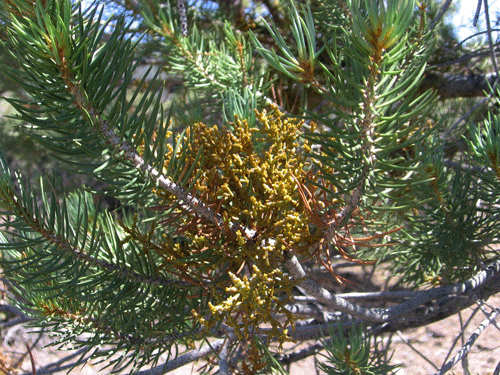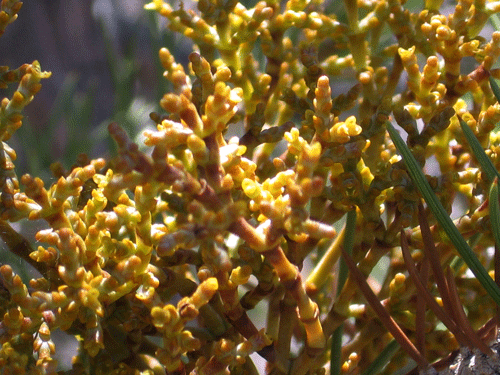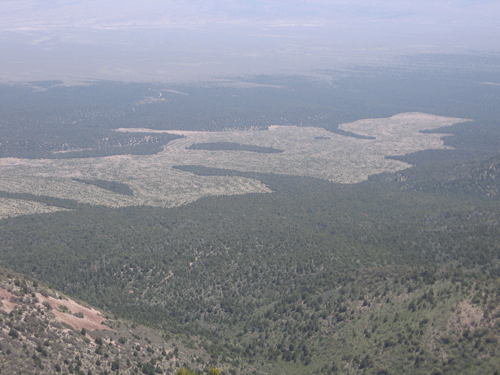CALIFORNIA NATIVE PLANT SOCIETY
Channel Islands Chapter
Channel Islands Chapter
Rare Plant Profiles:  Arceuthobium divaricatum
Arceuthobium divaricatum
 Arceuthobium divaricatum
Arceuthobium divaricatum


Arceuthobium divaricatum ranges from southern California to western Texas, including Nevada, Utah, and Colorado, and northern Mexico. This range is generally the same distribution of its host plants, Pinus monophylla, P. edulis, and P. quadrifolia, pinyon pines. In California, it is known from Fresno, Inyo, Kern, Los Angeles, Mono, San Bernardino, and Ventura Counties. A total of 67 voucher specimens have been deposited in one or more public California herbaria, representing a total of approximately 52 distinct populations:
- 2 in eastern Fresno County (Sierra Nevada);
- 12 in Inyo County;
- 3 in eastern Kern County;
- 6 in northern Los Angeles County;
- 1 in Mono County (White Mountains in Jeffrey Mine Canyon at 7,600 ft);
- 27 in San Bernardino County; and
- 2 in northern Ventura County, and 7 other known (unvouchered) northern Ventura County occurrences.
Rarity Status
Global rarity ranking: G5.
State rarity ranking: not ranked.
CNPS State Inventory: Not listed.
CNPS Ventura County Uncommon, between 6 and 10 populations countywide (Magney 2008).
Impacts/Threats to Species
Arceuthobium divaricatum is threatened with extirpation locally from timber harvesting (for firewood), mining (such as for mine expansion at Pacific Custom Materials/TXI’s Ridgelite Mine in northeastern Ventura County, and mistletoe eradication efforts by the U.S.D.A. Forest Service, who considers all mistletoe species to be serious pests. The BLM has cleared hundreds of acres of Pinyon-Juniper Woodland habitat in eastern Nevada, eliminating habitat (e.g. northeastern flank of Wilson Creek Range in Lincoln County), and possibly populations of, Arceuthobium divaricatum.

Recommendations
Due to the scarcity of populations of Arceuthobium divaricatum in California, and because of anthropogenic threats to it, the following recommendations are made:
CNDDB State rarity ranking: S2.2
CNPS List: 2.2 or 4.2
CHANNEL ISLANDS CHAPTER, CALIFORNIA NATIVE PLANT SOCIETY, PO Box 6, Ojai, CA 93024-0006
Special thanks to Carlin Moyer for the beautiful illustrations on our site. Photographs and maps are by David Magney.
Created: 11 September 2008; Last updated: 11 September 2008
For website comments: webmaster(at)cnpsci(dot)org
For website comments: webmaster(at)cnpsci(dot)org
CNPS HOME | SITE MAP | CHANNEL ISLANDS CHAPTER HOME